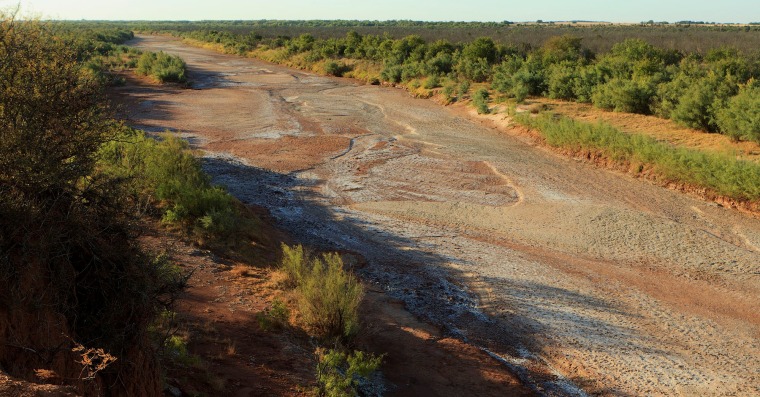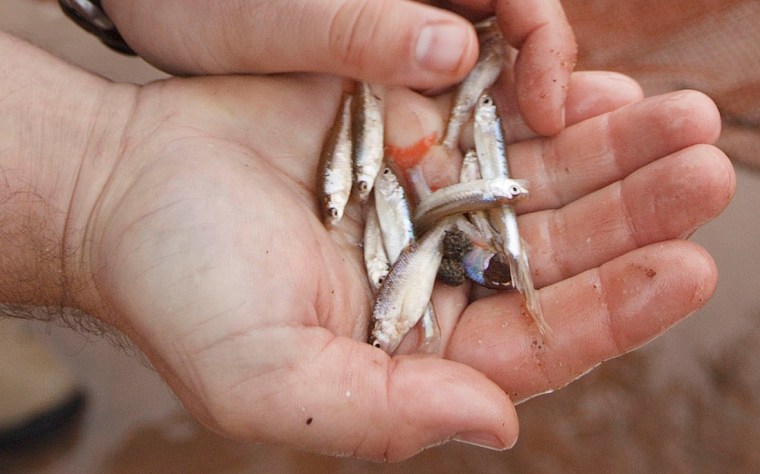Wildlife biologists have evacuated two species of minnows from the shrinking waters of a West Texas river in the first of several rescue operations involving fish affected by the state's worst drought in decades.
Smalleye shiners and sharpnose shiners, the species collected Thursday and Friday from the Brazos River about 175 miles northwest of Fort Worth, were taken to the state's fish hatchery near Possum Kingdom Lake. When drought conditions abate, the minnows will be returned to the river.
Scorching conditions have left the water hot, muddy and salty in the river's Clear, Double Mountain and Salt forks. Because of the drought, the water levels were so low this year that the minnows — candidates to be listed as threatened or endangered under the federal Endangered Species Act — didn't have the 100 miles of river needed to reproduce.
Their life span is just two years, so scientists are scrambling to save the two species, which wildlife officials say are the most abundant fish in the upper Brazos and are found nowhere else in the world.
"If this drought continues for another year and they haven't reproduced ... we may lose the entire population," said Gene Wilde, a fish ecology professor at Texas Tech who has spent much of his life studying fish in West Texas rivers.
"They've made it through hot summers before, but this is different," Wilde added. "Flows at all of the stream gauges heading down to Possum Kingdom are reading zero."
This kind of large-scale evacuation of fish is rare. One was ordered in 2000 to rescue several species of mussels in Georgia, and more recently Wilde led a team that rescued the threatened Arkansas River shiner from the Canadian River in the Panhandle.
As the drought conditions persist, the rescues will become more common this fall for fish, amphibians and other creatures in Texas, home to 86 species considered endangered or threatened.
There has been a push for more fish evacuations in Central and West Texas.
The San Saba, Colorado and Llano rivers are home to several species of mussels, some of which are listed as threatened in Texas and for which petitions are pending for federal status.
Several federally endangered species — including the fountain darter and the Texas blind salamander — could need rescuing from the Comal and San Marcos Springs, south of Austin. If stream flows drop to pre-determined trigger levels, biologists with the U.S. Fish and Wildlife Service will evacuate as many samples of the species as possible.

About 88 percent of the state is enduring the worst stage of drought, according to the U.S. Drought Monitor map released Thursday. The state just finished its driest 11 months on record and is in the state's worst single-year drought ever. Texas also had the hottest June through August on record in the U.S.
When the Brazos River and its forks have healthy flows, the minnows live by picking bugs out of the water or sifting through the sandy dunes formed by currents. They can migrate more than 100 miles upstream to spawn and release their buoyant eggs to float downstream to hatch.
The 2-inch-long minnows are prey to game fish like catfish or largemouth bass, according to a release Thursday from the Texas Parks and Wildlife Department.
"These fish are a unique part of Texas’ natural heritage," Wilde said in the release. "They’re found only in Texas in the Brazos River, and nowhere else in the world. Right now, they’re the most abundant fish in the upper Brazos.
"When it comes to prey availability for game fish like catfish or largemouth bass," he added, "these fish drive the system. If we lose them, we won’t have the same ecological vitality."
